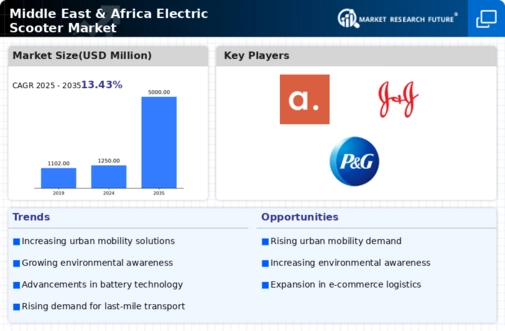Middle East And Africa Electric Scooter Size
middle-east-and-africa Electric Scooter Market Growth Projections and Opportunities
The Middle East & Africa Electric Scooter Market is influenced by a variety of market factors that shape its growth and development. One of the key factors driving the market is the increasing awareness of environmental sustainability. With growing concerns about pollution and carbon emissions, there's a rising demand for eco-friendly transportation options like electric scooters. Governments and environmental organizations are also promoting the adoption of electric vehicles, including scooters, through incentives and policies aimed at reducing emissions.
Additionally, urbanization plays a significant role in the growth of the electric scooter market in the Middle East & Africa region. As cities become more congested, people are seeking alternative modes of transportation that are efficient and convenient for short-distance travel. Electric scooters offer a solution by providing a compact and agile means of getting around urban areas without contributing to traffic congestion or pollution.
Furthermore, the market is influenced by technological advancements in electric scooter design and manufacturing. Improvements in battery technology have extended the range and reduced the charging time of electric scooters, making them more practical for everyday use. Moreover, the integration of smart features such as GPS navigation, smartphone connectivity, and anti-theft systems enhances the appeal of electric scooters to tech-savvy consumers.
Another important factor driving the market is the increasing investment in infrastructure to support electric mobility. Governments and private companies are investing in charging infrastructure to address the range anxiety associated with electric vehicles, including scooters. The expansion of charging networks in urban areas and along major transportation routes is critical for the widespread adoption of electric scooters in the Middle East & Africa region.
Furthermore, changing consumer preferences and lifestyles are influencing the market dynamics of electric scooters. Millennials and younger generations, in particular, are more inclined towards sustainable and tech-driven transportation options. Electric scooters offer a convenient and cost-effective way to commute, especially for short trips within cities. Additionally, the rise of the gig economy and shared mobility services has created a demand for electric scooters as a mode of transportation for delivery and last-mile logistics.
However, the market faces challenges such as limited infrastructure and regulatory hurdles. The lack of charging infrastructure in certain areas limits the adoption of electric scooters, particularly in less developed regions. Moreover, regulatory issues related to vehicle registration, licensing, and safety standards can hinder the growth of the market. Addressing these challenges will require collaboration between governments, industry stakeholders, and regulatory bodies to create a conducive environment for the electric scooter market to thrive.
In conclusion, the Middle East & Africa Electric Scooter Market is influenced by various market factors ranging from environmental concerns and urbanization to technological advancements and changing consumer preferences. While the market offers significant growth opportunities, it also faces challenges that need to be addressed to unlock its full potential. With the right investment in infrastructure, supportive policies, and innovative solutions, the electric scooter market in the Middle East & Africa region can play a crucial role in promoting sustainable and efficient urban mobility.








Leave a Comment